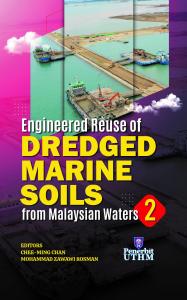Engineered Reuse of DREDGED MARINE SOILS from Malaysian Waters 2
Keywords:
Reclamation, marine soil, granula, contaminationSynopsis
This is the second book in the series written to give an insight to some feasible techniques for reusing dredged marine soils.
The reuse potential of the treated soils can be found in reclamation works as well as landfill liners. Admixed with stabilising agents and granular materials, the originally soft and weak dredged marine soils can be transformed into stable backfills in artificial land
creation. The granular additions could be sourced from industrial or construction wastes, further enhancing the sustainable and
responsible use of natural resources. For reuse in landfills, microbial activity in the soil serves as a bioindicator of contamination risks, especially from the leachate retention pond. In short, engineered solutions applied to the otherwise waste material could effectively
give second lives to the dredged marine soils, minimising the need
for customised dump sites, as well as additional transportation and
operational costs in the long run.
Downloads
References
Ashraf, M. A., Maah, M. J., Yusoff, I., Wajid, A. & Mahmood, K. (2011). Sand Mining Effects, Causes and Concerns: A Case Study from Bestari Jaya, Selangor, Peninsular Malaysia. Scientific Research and Essays, 6(6), pp. 1216-1231.
Barnett, S.J., Soutsos, M.N, Bungey, J.H. & Millard, S.G. (2005). The effect of the level of cement replacement with ground granulated blastfurnace slag on the strength development and adiabatic temperature rise of concrete mixtures, in: R.K. Dhir (Ed.), Proceedings of Global Construction: Ultimate Concrete Opportunities, Event 1: Cement Combinations for Durable Concrete, Dundee, UK, (July), pp. 165–172
Chan, C-M. & M. Yusof, M. N. Remoulded Strength of High Plasticity Marine Silt Retrieved from Maintenance Dredging. Modern Applied Science. 2015. 9(6): 13-19.
Chan, C-M. & Yong, H-Y. Comparing the Thixotropic and Lightly Solidified Hardening Behavior of a Dredged Marine Clay.
Engineering, Technology & Applied Science Research. 2014. 4(5): 706-710.
Di Maio, C., Santoli, L. Schiavone, P. (2004). Volume Change Behavior of Clays: The Influence of Mineral Composition, Pore Fluid Composition and Stress State. Mech. Matter, 36(5), pp. 435-451.
Duncan, J. M. & Bursey, A. (2013). Soil Modulus Correlations. Foundation Engineering in the Face of Uncertainty, pp. 321-336.
Ge, L., Wang, C. C., Liao, C. W. & Zhao, H. (2018). Assessment of strength development of slag cement stabilised kaolinite. Construction & Building Materials, 184, pp. 492-501.
Ekinci, A. (2019). Effects of preparation methods on strength and microstructural properties of cemented marine clay. Construction & Building Materials, 227, 116690.




